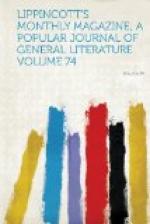falls in a cascade. The road to the Sweet Waters,
with one or two others, was made after the sultan’s
return from his European trip, and in anticipation
of the empress Eugenie’s visit. European
carriages were also introduced at that time. The
ladies of the sultan’s harem drive out in very
handsome coupes, with coachmen wearing the sultan’s
livery, but you more frequently see the queer one-horse
Turkish carriage, and sometimes a “cow-carriage.”
This last is drawn by cows or oxen: it is an
open wagon, with a white cloth awning ornamented with
gay fringes and tassels. Many people go in caiques,
and all carry bright-colored rugs, which they spread
on the grass. There they sit for several hours
and gossip with each other, or take their luncheons
and spend the afternoon. A Turkish woman is never
seen to better advantage than when “made up”
for such an excursion. Her house-dress is always
hidden by a large cloak, which comes down to the ground
and has loose sleeves and a cape. The cloak is
left open at the neck to show the lace and necklace
worn under it, and is generally made of silk, often
of exquisite shades of pink, blue, purple or any color
to suit the taste of the wearer. A small silk
cap, like the low turbans our ladies wore eight or
nine years ago, covers the head, and on it are fastened
the most brilliant jewels—diamond pins,
rubies, anything that will flash. The wearer’s
complexion is heightened to great brilliancy by toilet
arts, and over all, covering deficiencies, is the
yashmak or thin white veil, which conceals only in
part and greatly enhances her beauty. You think
your “dream of fair women” realized, and
go home and read
Lalla Rookh and rave of Eastern
peris. Should some female friend who has visited
a harem and seen these radiant beauties face to face
mildly suggest that paint, powder and the enchantment
of distance have in a measure deluded you, you dismiss
the unwelcome information as an invention of the “green-eyed
monster,” and, remembering the brilliant beauties
who reclined beside the Sweet Waters or floated by
you on the Golden Horn, cherish the recollection as
that of one of the brightest scenes of the Orient.
These I have spoken of are the upper classes from
the harems of the sultan and rich pashas, but those
you see constantly on foot in the streets are the
middle and lower classes, and not so attractive.
They have fine eyes, but the yashmaks are thicker,
and you feel there is less beauty hidden under them.
The higher the rank the thinner the yashmak is the
rule. They also wear the long cloak, but it is
made of black or colored alpaca or a similar material.
Gray is most worn, but black, brown, yellow, green,
blue and scarlet are often seen. The negresses
dress like their mistresses in the street, and if you
see a pair of bright yellow boots under a brilliant
scarlet ferraja and an unusually white yashmak, you
will generally find the wearer is a jet-black negress.
Sitting so much in the house a la Turque is
not conducive to grace of motion, nor are loose slippers
to well-shaped feet, and I must confess that a Turkish
woman walks like a goose, and the size of her
“fairy feet” would rejoice the heart of
a leather-dealer.




